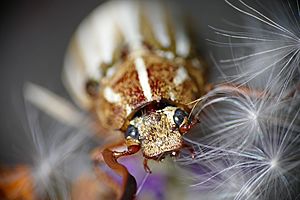Mount Hermon June beetle facts for kids
Quick facts for kids Mount Hermon June beetle |
|
|---|---|
| Conservation status | |
| Scientific classification | |
| Kingdom: | |
| Phylum: | |
| Class: | |
| Order: | |
| Family: | |
| Subfamily: |
Melolonthinae
|
| Genus: |
Polyphylla
|
| Species: |
P. barbata
|
| Binomial name | |
| Polyphylla barbata Cazier, 1938
|
|
The Polyphylla barbata is a very rare beetle. It is also known as the Mount Hermon June beetle. This beetle is only found in California, specifically in Santa Cruz County.
It lives in a small area, less than 1,500 acres (6.1 km2) big. Because it is so rare, the United States government has listed it as an endangered species. This means it is protected by law to help it survive.
Contents
What the Mount Hermon June Beetle Looks Like
This beetle is about 2 centimeters long, which is less than an inch. It has a mix of black and brown colors. You can see broken white stripes running down its back.
Its hard wing covers, called elytra, are covered in a thin layer of tiny hairs. The female beetle is a little bit bigger than the male.
Life Cycle and Habits
The Mount Hermon June beetle spends most of its life underground as a larva. A larva is a young insect that looks like a grub. This part of its life cycle can last for 2 to 3 years.
The adult beetles might not eat at all. The larvae probably eat plant roots and special fungi called mycorrhizal fungi. These fungi help plants grow.
Adult Beetle Activity
Female beetles stay mostly underground. They only come out to mate with the males. Male beetles fly around from mid-June to late July.
They are most active in the evening, usually between 8:45 and 9:30 pm. When a male beetle flies, its wings make a crackling sound. The adult male beetle lives for only about a week. The female probably dies soon after she lays her eggs.
Where the Mount Hermon June Beetle Lives
Scientists first described this beetle in 1938. The first one was found near Mount Hermon, California. This beetle only lives in a special area called the Zayante sandhills.
This region is found around Mount Hermon, Scotts Valley, and Ben Lomond. These places are all in the Santa Cruz Mountains of California. Another endangered insect, the Zayante band-winged grasshopper, also lives in this same area.
Its Home Environment
The beetle's home is in ponderosa pine forests and chaparral. Chaparral is a type of shrubland. These areas have open, sandy spots that are like small pockets within the surrounding hills.
Many rare plants also grow here. Some of these include the Ben Lomond wallflower, the Ben Lomond spineflower, and the Santa Cruz cypress.
Threats to the Beetle
More than 40% of the Zayante sandhills region has been lost. This is due to human activities like building new homes and sand mining. Many of the places where the beetle lives are very close to active sand mining operations.
Also, stopping natural fires in the area has changed the plants that grow there. Plants that can handle fire are being replaced by other types of plants. This changes the beetle's natural home.



